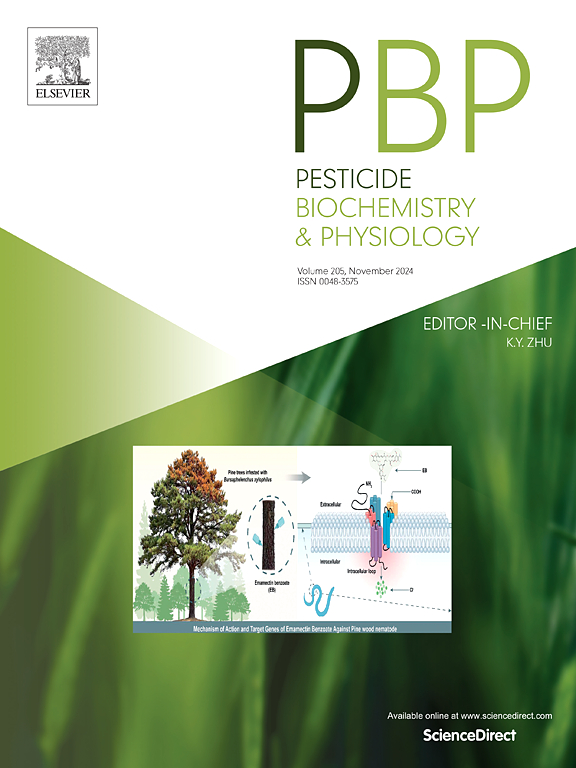韩国5种蜚蠊杀虫剂抗性突变频率的分子分析
IF 4.2
1区 农林科学
Q2 BIOCHEMISTRY & MOLECULAR BIOLOGY
引用次数: 0
摘要
蟑螂是主要的城市害虫,由于其传播病原体和产生杀虫剂抗性的能力,对公共卫生构成威胁。在大韩民国(ROK),耐药性监测传统上依赖于生物测定,对耐药性相关突变的研究有限。本研究检测了5种蜚蠊(德国小蠊、日本小蠊、美洲大蠊、日本大蠊和富力大蠊)中kdr和rdl突变对拟除虫菊酯和氟虫腈(一种苯吡唑杀虫剂)产生抗性的流行情况。采用定量测序方法对243个地区1278只蜚蠊进行了分析。结果显示,在169个地区样本中,德国小蠊普遍存在抗性,kdr突变(L993F)和rdl突变(A302S)的总频率分别为57.1%和94.2%。未发现其他kdr突变E434K或C764R的证据。值得注意的是,尽管日本芽孢杆菌最近在室内环境中出现,但未表现出可检测到的抗性突变,这可能是由于农村地区接触杀虫剂较少。同样,在大蠊物种中没有发现kdr突变,而rdl突变仅在一个美洲蠊区域样本中被检测到,这是第一个记录在案的病例。鉴于对氟虫腈的抗药性日益增强,需要替代杀虫剂来有效管理蟑螂。呋虫胺是一种新烟碱类杀虫剂,以前在蟑螂控制中使用有限,是一种有希望的候选杀虫剂,因为它的有毒诱饵产品已经在韩国上市。溴flanilide和异环seram也显示出潜力,但需要监管部门的批准。这些发现突出表明,需要持续监测耐药性并采取主动虫害管理战略。本文章由计算机程序翻译,如有差异,请以英文原文为准。

Molecular analysis of insecticide resistance mutation frequencies in five cockroach species from Korea
Cockroaches are major urban pests that pose public health risks due to their ability to transmit pathogens and develop insecticide resistance. In the Republic of Korea (ROK), resistance monitoring has traditionally relied on bioassays, with limited studies on resistance-associated mutations. This study examined the prevalence of kdr and rdl mutations, conferring resistance to pyrethroids and fipronil (a phenylpyrazole insecticide), respectively, in five cockroach species (Blattella germanica, Blattella nipponica, Periplaneta americana, Periplaneta japonica, and Periplaneta fuliginosa). A total of 1278 cockroaches from 243 regional samples were analyzed using quantitative sequencing. Results showed widespread resistance in B. germanica, with an overall frequency of 57.1 % for the kdr mutation (L993F) and 94.2 % for the rdl mutation (A302S) across 169 regional samples. No evidence of other kdr mutations, E434K or C764R, was found. Notably, B. nipponica, despite its recent emergence in indoor environments, exhibited no detectable resistance mutations, likely due to lower insecticide exposure in rural areas. Similarly, no kdr mutations were found in Periplaneta species, and the rdl mutation was detected in only a single P. americana regional sample, marking the first documented case. Given the increasing resistance to fipronil, alternative insecticides are needed for effective cockroach management. Dinotefuran, a neonicotinoid with limited prior use in cockroach control, is a promising candidate, as its toxic bait products are already available in the ROK. Broflanilide and isocycloseram also show potential but require regulatory approval. These findings highlight the need for ongoing resistance monitoring and proactive pest management strategies.
求助全文
通过发布文献求助,成功后即可免费获取论文全文。
去求助
来源期刊
CiteScore
7.00
自引率
8.50%
发文量
238
审稿时长
4.2 months
期刊介绍:
Pesticide Biochemistry and Physiology publishes original scientific articles pertaining to the mode of action of plant protection agents such as insecticides, fungicides, herbicides, and similar compounds, including nonlethal pest control agents, biosynthesis of pheromones, hormones, and plant resistance agents. Manuscripts may include a biochemical, physiological, or molecular study for an understanding of comparative toxicology or selective toxicity of both target and nontarget organisms. Particular interest will be given to studies on the molecular biology of pest control, toxicology, and pesticide resistance.
Research Areas Emphasized Include the Biochemistry and Physiology of:
• Comparative toxicity
• Mode of action
• Pathophysiology
• Plant growth regulators
• Resistance
• Other effects of pesticides on both parasites and hosts.

 求助内容:
求助内容: 应助结果提醒方式:
应助结果提醒方式:


